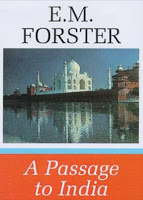EM Forster's Passage to India
 EM Forster’s most famous book is arguably A Passage to India. I use the term ‘arguably’ because I don’t agree with this, and after finishing the novel a few weeks ago, I have tried to figure out why. Harold Bloom’s observation that, though Passage is a brilliant book, "no one character is larger than the novel" begins to explain my response. Unlike Howards End, with the dashing Margaret, the conflicted Helen, the ethereal Mrs. Wilcox, no character in Passage rises from the narrative to become their own personality outside of the novel. One would never talk about a Miss Quested like they talk about Emma Bovary or Jay Gatsby. She is completely confined to the context of her novel and there remains.
EM Forster’s most famous book is arguably A Passage to India. I use the term ‘arguably’ because I don’t agree with this, and after finishing the novel a few weeks ago, I have tried to figure out why. Harold Bloom’s observation that, though Passage is a brilliant book, "no one character is larger than the novel" begins to explain my response. Unlike Howards End, with the dashing Margaret, the conflicted Helen, the ethereal Mrs. Wilcox, no character in Passage rises from the narrative to become their own personality outside of the novel. One would never talk about a Miss Quested like they talk about Emma Bovary or Jay Gatsby. She is completely confined to the context of her novel and there remains.This explanation partially elucidates my lukewarm reaction to the novel. I think the other has to do with the fact that Passage seems unfinished by the very nature of the themes that it contemplates. For some, this may help to explain its genius. However, if one judges this novel on structure and character presentation, one finds that it fails completely in these regards. Passage is not a perfect novel. There is far too much exposition – the main drama of the novel not appearing until almost 200 pages in – and the characters, as mentioned before are somewhat dull.
What Forster does do well, though, is depict a collision of cultures. Forster is not an imperialist and this has kept Passage on our reading lists, as opposed to Kipling, who, with his white man’s burden business, has at best been relegated to the children’s shelves and at worst been completely maligned by critics who have no use for his version of the hierarchy of cultures. Forster is sympathetic to India’s plight, but he’s measured in his presentation of both sides. Both the English and the Indians have moments of prejudice and hatred, openness and understanding. These latter gestures are what ultimately bring about the devastation of the novel. Forster’s main point is that neither side is ready to come across the divide, that the point of melding cultures, forgiving, moving forward is not yet here. (One wonders if it’s even here now.)
What Forster does do well, though, is depict a collision of cultures. Forster is not an imperialist and this has kept Passage on our reading lists, as opposed to Kipling, who, with his white man’s burden business, has at best been relegated to the children’s shelves and at worst been completely maligned by critics who have no use for his version of the hierarchy of cultures. Forster is sympathetic to India’s plight, but he’s measured in his presentation of both sides. Both the English and the Indians have moments of prejudice and hatred, openness and understanding. These latter gestures are what ultimately bring about the devastation of the novel. Forster’s main point is that neither side is ready to come across the divide, that the point of melding cultures, forgiving, moving forward is not yet here. (One wonders if it’s even here now.)
This notion of “not yet” puts the structure of the novel in limbo and necessitates an ambiguous ending. Clearly, Passage, like Howards End, is an idea novel, but unlike Howards End, it is not neatly packaged into a three part plot structure. Howards End ends nicely, and fittingly, at the eponymously named farm; Passage parts from the reader with an intimation of a huge comma. For Forster to tidy up the “not yet,” to bring the conclusion to the “now,” a number of things must happen – all outside the scope of the plot – and Forster chooses for reality here over fairy tale. He could have easily finished the novel with a coming together of the English and the Indian, but this would undercut the previous 300+ pages. It would force a conclusion in fiction where none could happen in life.
This unresolved ending, and Forster’s commitment to truth is, as I mentioned earlier, what many credit as the genius of the novel, and as I think about it from this perspective – divorcing myself from the personal expectation that a novel should have a definitive conclusion – I understand that this is the only way Passage could end and be considered successful.
This unresolved ending, and Forster’s commitment to truth is, as I mentioned earlier, what many credit as the genius of the novel, and as I think about it from this perspective – divorcing myself from the personal expectation that a novel should have a definitive conclusion – I understand that this is the only way Passage could end and be considered successful.

If I'd had to guess Forster's most famous book, I'd have probably said "Howards End", actually. I wonder if that doesn't say more about me and my own lack of knowledge than anything else... I haven't read either "A Passage to India" or "Howards End" yet, but this review makes me actually more inclined to start with "A Passage to India". I'd rather see Forster "improve" as a writer, I suppose...
ReplyDelete